Bathroom Screens: Types, How to Choose the Right One, Which is Better and Why
Wanting to reduce the cost of plumbing, the manufacturer produces products with a minimum set of devices and appliances, giving us the opportunity to independently decide whether to buy or not to buy screens for the bathroom.
And not everyone wants to buy exactly plastic panels, if there are other materials. How to choose the most suitable option, what should I look for when buying or making an individual order?
The content of the article:
Product configuration and design features
The design of the screen, which is installed under the bath, consists of a set or only one front panel and frame, which is made in the form of two guides or a frame. The decorative screen can be straight or angular, solid or consist of several elements made in the form of swing or sliding doors.
The main difference between the screen and the panel is that the latter is mainly made of plastic by the bath manufacturers themselves. It clearly fits in shape and size to the bowl of the same model. By choosing the right panel, you can be sure that the dimensions fit perfectly.
The screen layout may also differ: strictly vertical, tilted at an angle, with a notch for the legs. Both options have their pros and cons. The first will not allow you to come close to the bath, make it uncomfortable to maintain, the second will worsen the appearance, create an acute angle between the floor and the screen, which will be difficult to mop.
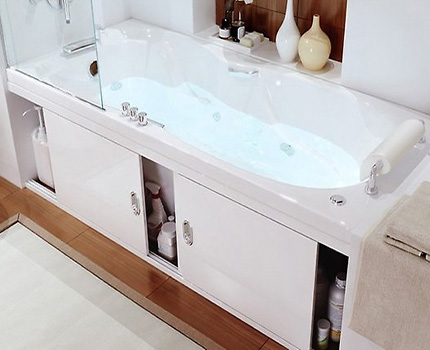
The sizes of the finished screens that go on sale have standard values.The front panels are produced with the following widths: 75 cm, 85 cm, 90 cm, 102 cm, 120 cm. Front cousins can be from 130 to 210 cm in size. Their height is from 40 to 60 cm. If none of the options fits, You can order a product with the desired parameters.
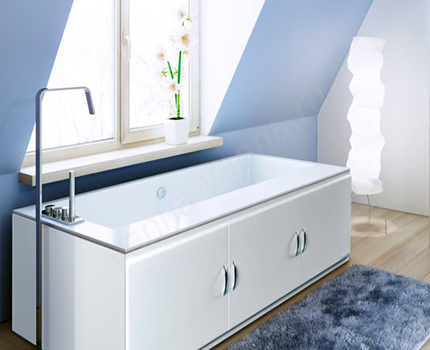
Screens are equipped with two or three legs, the bottom of which is equipped with plastic to protect against slipping. They are adjustable, therefore, it is not difficult to choose the required height, especially taking into account the fact that the height of the bowls is basically standard. With the help of the legs, the screen is installed in surprise, protecting the space under the bath from moisture.
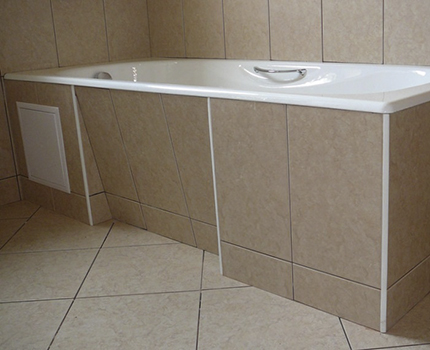
When choosing a product, it is important to evaluate the quality of the accessories used. Handles, frame and guides must be made of non-corrosive material. Otherwise, it may happen that the screen will serve for many years, and the peeling coating will “please” you as much.
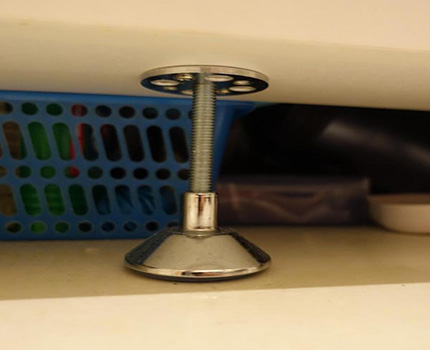
What material to choose the panel for the bath
Since the main purpose of the screen, in addition to decorative, is to protect the space under the bath from moisture, the materials for the manufacture of products must be water repellent and not deteriorate when exposed to steam with water.
Almost all materials that are used in the manufacture of bath screens have this property, but there are also those whose use is perplexing.
MDF screen: aesthetics or practicality?
A screen with a panel of MDF is most often performed in the form of swing or sliding doors. Inside can be equipped with a shelf. Such a decorative panel looks much more beautiful than the plastic type, in addition, when ordering furniture from MDF to the bathroom, it is possible to choose a product in the same style, color scheme.
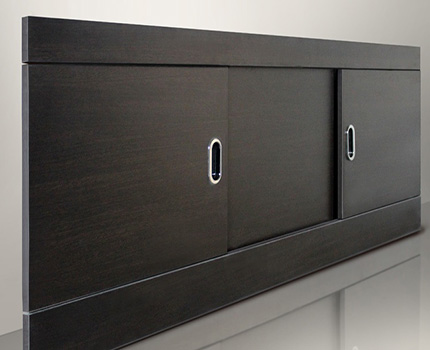
Of the main disadvantages is the weak resistance to the effects of a humid environment. Despite the fact that the production uses moisture-resistant MDF, in case of frequent contact with water, the material swells, the external coating exfoliates.
The frame, which is made of moisture-resistant chipboard or wooden blocks, is also afraid of moisture. Negative customer reviews of MDF panels claim that problems begin to appear as early as six months after installation. Another drawback is that the material is difficult to cut.
If the finished product does not fit and needs to be adjusted, then this will be problematic. The fact is that MDF needs to be cut on powerful equipment used in woodworking with a large number of revolutions, otherwise the edges of the cut will be torn. A conventional hacksaw or electric jigsaw can greatly ruin the appearance of the product.
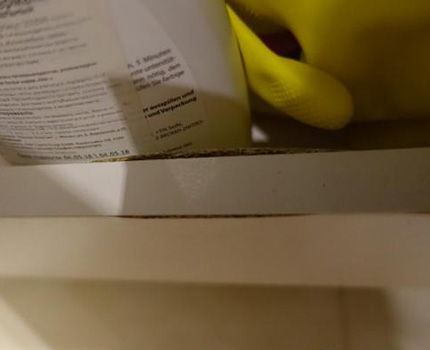
Aluminum bath screen: reliability and variety
Aluminum screens are primarily an aluminum profile frame. Plexiglas, MDF panels, and PVC can be used as decorative panels. The assortment of products with different designs is quite high, you can choose for every taste.
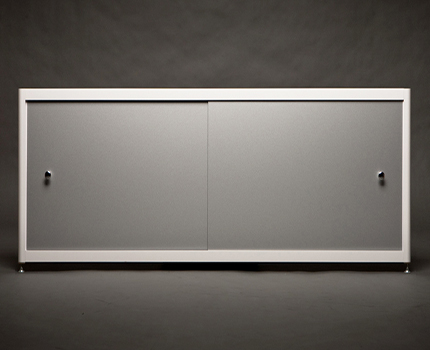
The main properties of the screen, which are self-evident, even without reading the manufacturer's characteristics, are reliability and durability.
The aluminum frame and guides do not corrode, the products tolerate mechanical loads well, do not deform under the influence of moisture. Not the lowest cost pays off due to the durability of the material.
Plastic decorative panels for the bath: pros and cons
The screen is a panel made of cellular plastic, which is installed in a case-frame made of PVC or aluminum profile. The cheapest and most common models are white. Also released are screens coated with a self-adhesive film of various colors, including those with a 3D pattern.
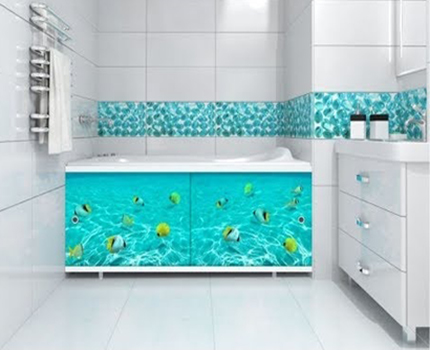
The popularity of plastic screens can be explained by several advantages:
- ease of installation, fitting to the required size;
- low cost in comparison with panels of other materials;
- the largest variety of sizes, shapes, designs, colors and ornaments;
- insensitivity to high humidity, to direct and prolonged contact with water;
- long service life - depending on the quality of production, from 10 to 30 years are used.
Judging by user reviews, plastic screens are not too solid construction, and some models can directly be called fragile. Therefore, they require careful handling, they must be protected from shock. Do not use abrasive materials to wash the panels.
Glass screen: longevity despite its apparent fragility
For the manufacture of glass screens for the bath using tempered glass. The material has all the necessary qualities for use in the bathroom: it is moisture-resistant, strong, durable, easy to clean and, unlike plastic, is not susceptible to scratches and the formation of plaque.
Glass panels can be solid, with sliding, opening or folding doors. The frame is made of aluminum alloy, which is coated with powder enamel.
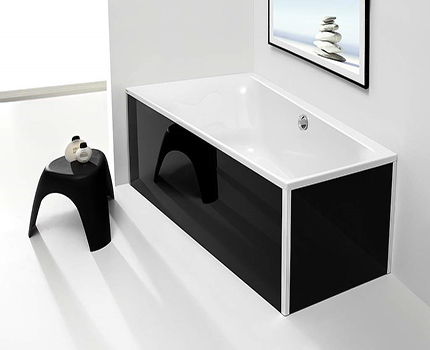
Bathtubs are also available. mirror screensthat look great in the interior and visually expand the space. The disadvantage of such products is their considerable cost and fragility.
In addition, mirror panels are more difficult to care for, as fingerprints and splashes of water are clearly visible on the surface. To maintain cleanliness, they must be constantly cleaned.
Tiles and mosaics - traditional quality
During the repair, the choice of protective and decorative cladding makes it possible to focus on the already traditional mosaic or ceramic tile finish. Such a solution will allow to maintain a single style, and homemade screen will serve as good protection against moisture and will last until the next overhaul.
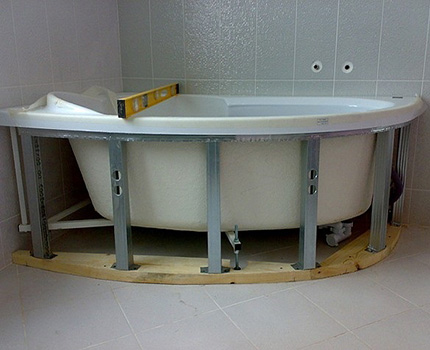
Facing with ceramics, in comparison with other options, is more expensive, especially if the tiles in the bathroom are used not cheaply, and more time and effort are required for installation. But the result will be pleasing to the eye, and you can forget about the maintenance or repair of the screen for a long time.
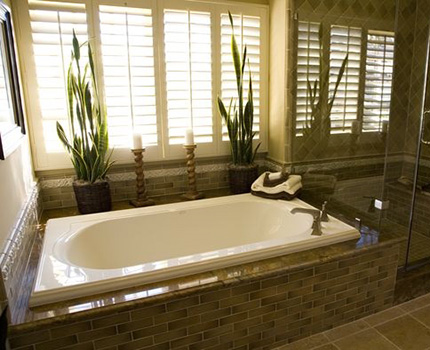
The basis for the tile can serve as a surface made of moisture-resistant drywall or tongue-and-groove plates, brickwork. For an oval or semicircular bowl, it is easier to use polystyrene plates.The frame is installed from a galvanized metal profile. Less commonly tile screen built of wooden blocks.
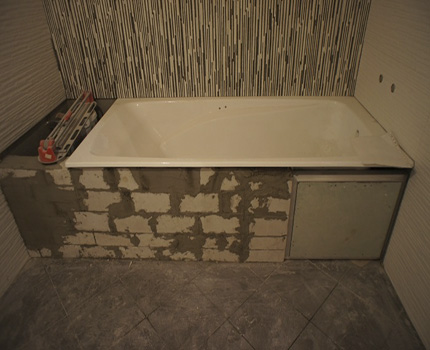
The main requirement for the material is moisture resistance, strength, it should not be deformed under the weight of the lining. In some cases, chipboard is also used, but its use in a bathroom is extremely undesirable, since it is afraid of contact with water.

Self-developed design allows you to competently and conveniently organize the space closed by a decorative and protective panel. How to make a screen with shelves and departments, find out their recommended article.
Natural materials for bath design
The desire to use natural materials more and more in interior design was the impetus for the creation of wood screens. It would seem that this material can in no way be used where it will often come into contact with water.
But modern manufacturing and processing technologies help to do the impossible. New wood preservatives allow the use of natural material outdoors, in the open air and, of course, in the bathroom.
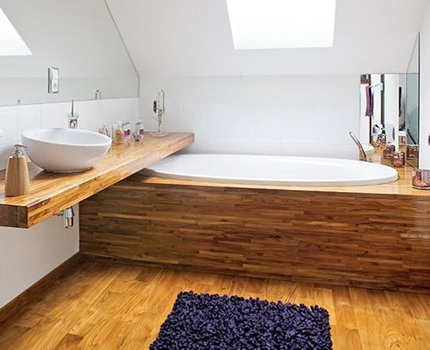
Less commonly, you can find natural or artificial stone finishes. This design option is a great alternative to tile. And although the cost is quite high, but natural or mimicking their materials will last a long time and will always be relevant, they will not go out of fashion.
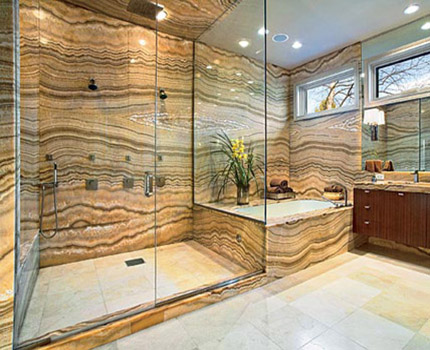
Features of the installation of decorative panels
Ready-made screens, subject to compliance with all sizes, are installed quickly enough. But sometimes the height of the legs is not enough to close the space under the bowl. Then regular bolts are replaced with longer ones.
Problems can also arise if the bathtub is not installed horizontally. In this case, it is better to check the installation level of the plumbing itself and fix this situation.
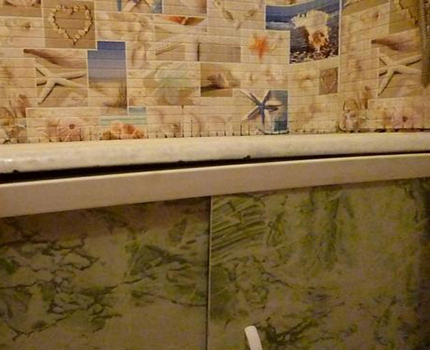
Mismatch in product width can also complicate installation. The screen, which is wider than necessary, is reduced by cutting the frame on the sides. But you need to be prepared that not every product can be cut. If the screen is smaller, then the remaining space is covered with a small wall of drywall.
Despite the variety of models, sometimes you still have to make a screen with your own hands. This also happens because the required size or shape may not be available. The incentive for independent construction of a decorative panel can also be the desire to maintain the style, to realize the original plan, to maximize the use of the bathroom space.
Installing a screen yourself is easier if you expect a one-piece design. If there is a desire to provide maximum access to the bath, to use this space for storing things, then it is better to use a screen with doors.
But to establish sliding bath screen it will be harder and hardly cheaper on your own. For bathtubs in standard sizes and shapes, it might be better to consider ready-made options.
Conclusions and useful video on the topic
Video # 1. What material to choose the panel for the bath:
Video # 2. Presentation of the finished design for masking the space under the bathroom:
Video # 3. A variety of colors and patterns:
The screen for the bath is a fairly significant detail of the interior. Therefore, often the aesthetic factor outweighs the scales in their favor.
But we should not forget about the practical side and choose a decorative panel for the bath, not only beautiful, but also reliable, one that will last a long time without losing its appearance and without losing functionality.
Tell us about how you mounted a screen for arranging plumbing with your own hands. It is possible that your experience will be useful to site visitors. Please write comments in the block below, post photos here and ask questions about the topic of the article.

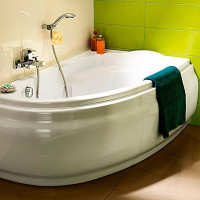 How to choose a good acrylic bath: which is better and why, manufacturers rating
How to choose a good acrylic bath: which is better and why, manufacturers rating 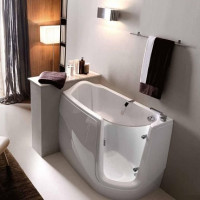 Sitting bathtubs for small bathrooms: views, device + how to choose
Sitting bathtubs for small bathrooms: views, device + how to choose  How and which bath is best to choose: an overview of options and recommendations for choosing
How and which bath is best to choose: an overview of options and recommendations for choosing 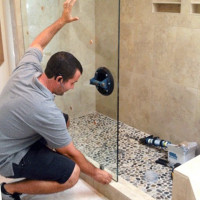 Glass for a shower cabin: how to choose and install with your own hands
Glass for a shower cabin: how to choose and install with your own hands 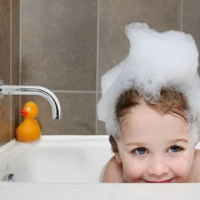 Care for the hot tub: how to properly maintain the equipment
Care for the hot tub: how to properly maintain the equipment 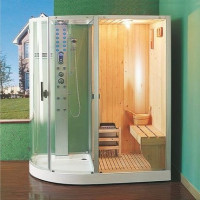 Shower cabin with sauna: how to choose the right one + review of the best manufacturers
Shower cabin with sauna: how to choose the right one + review of the best manufacturers  How much does it cost to connect gas to a private house: the price of organizing gas supply
How much does it cost to connect gas to a private house: the price of organizing gas supply  The best washing machines with dryer: model rating and customer tips
The best washing machines with dryer: model rating and customer tips  What is the color temperature of light and the nuances of choosing the temperature of the lamps to suit your needs
What is the color temperature of light and the nuances of choosing the temperature of the lamps to suit your needs  Replacement of a geyser in an apartment: replacement paperwork + basic norms and requirements
Replacement of a geyser in an apartment: replacement paperwork + basic norms and requirements
I bought a regular plastic screen that fit the size of the bathtub. The problem was that the bathtub was originally installed at an angle to the horizon, so I had to manually adjust it. Due to the insufficient rigidity of the structure, difficulties constantly arose with the movement of the panel. Also, a decorative ring, acting as a handle, quickly flew out. From now on, I will consider the options proposed here for updating the screen under the bathroom.
For a very long time in our bathroom there was no screen installation at all, but this did not affect the aesthetic appearance. Nevertheless, to create a certain style, we purchased plastic decorative panels with a 3d pattern. The design, frankly, turned out to be fragile and we replaced it with an aluminum profile option. It turned out to be an order of magnitude more expensive than plastic, but due to stability, this option wins.